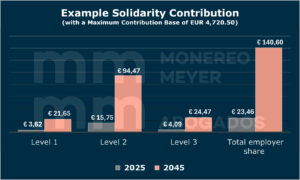One of the most important changes is the introduction of the new so called “solidarity contribution” (cuota de solidaridad), structured as an additional levy or surcharge on the portion of the salary that exceeds the maximum contribution base. The intention behind the measure is to strengthen pension financing, thus joining the Intergenerational Equity Mechanism (Mecanismo de Equidad Intergeneracional, MEI), equally aimed at increasing the financial resources in the pension fund.
Maximum Contribution Base and Surcharge Levels
The maximum contribution base for Spanish Social Security (base máxima de cotización or BMC) for 2024 – and for now, as no update has been published yet, also for 2025 – is EUR 4,720.50 per month. On every euro by which the salary exceeds this BMC, the solidarity contribution will be levied, with the following progression:
- Level 1: 0.92% for income that exceeds the BMC by up to 10%
- Level 2: 1.00% for income that exceeds the BMC by 10% to 50%
- Level 3: 1.17% for income that exceeds the BMC by more than 50%
By 2045, these percentages are to be gradually increased to 5.50 %, 6.00 % and 7.00 %, respectively.
Distribution and Calculation
The solidarity contribution is to be borne jointly by the employer and employee, with 83.39% being payable by the employer and 16.61% by the employee.
The calculation is reflected in the monthly contribution overview for employers (Recibo de Liquidación de Cotizaciones RLC, formerly known as TC1), but not in the overview of all registered employees (Relación Nominal de Trabajadores, RLT, formerly know as TC2). Furthermore, the solidarity contribution is not taken into account when determining the basis for benefits, grants and pensions.
Example
 Assuming the BMC would not change in 2025, a gross annual salary of EUR 90,000.00 would result in the following amounts for the solidarity contribution:
Assuming the BMC would not change in 2025, a gross annual salary of EUR 90,000.00 would result in the following amounts for the solidarity contribution:
- The BMC would be exceeded by a total of EUR 2,779.50 per month, resulting in a total solidarity contribution of EUR 28.13 per month.
- A share of EUR 23.46 would be borne by the employer and EUR 4.67 by the employee.
- In this example, the employer would incur additional costs of EUR 281.52 per year for every employee whose salary is above the Spanish BMC (EUR 4,720.50 per month or EUR 56,646.00 per year).
Main Effects for Employers and Employees
Additional costs for Employers
According to estimates, employers will face additional costs of up to 8 % in 2045. The first effects will be felt as early as 2025 with employees whose salary exceeds EUR 60,000.00 causing additional costs of EUR 280.00 per person and year.
Impact on Employees’ Net Salaries
Even if the initial impact on employees is small, the gradual increase until 2045 could lead to a significant reduction in net salaries, particularly for top earners.
No Changes for Benefits
The solidarity contribution is not taken into account when calculating the bases for future benefits, grants and pensions.
Conclusion
The new solidarity contribution brings significant changes, both, employers and employees, will have to adapt to. From 2025, employers will be faced with an increase in the cost of labour, which will intensify in subsequent years. Both, employers and employees, should be prepared for this change and assess its medium and long-term effects. However, many details will only become clear gradually, once the national budget for the respective year has been adopted.
The measure emphasises the commitment to ensuring the sustainability of pensions, but poses additional challenges for companies in terms of managing the cost of labour.
We would be happy to provide you with a detailed analysis of the impact of this new regulation on your company or personal situation. If you are interested, please contact us directly via our website https://acossolutions.es/en/contact/